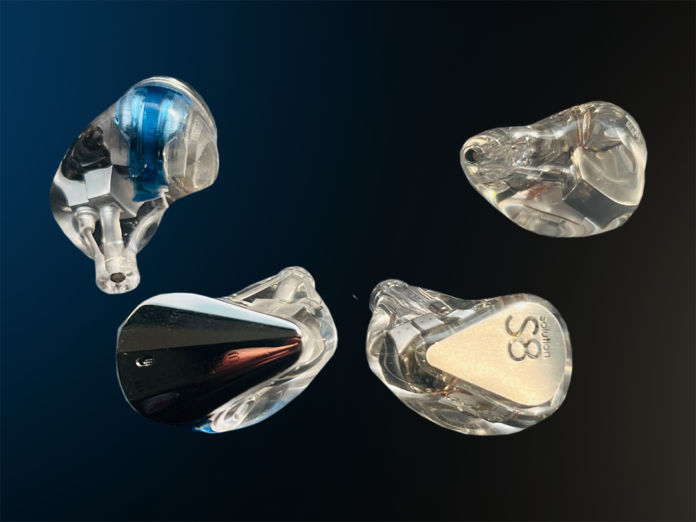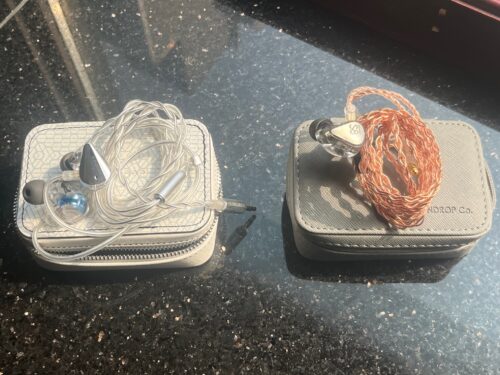The Blessing 3 has quickly become one of the most popular IEMs for entry-level audiophiles. And many comparison reviews have been written about the Blessing 3 and Blessing 2. But how does the Blessing 3 compare to pricier models from Moondrop, like the incredibly well-received S8? Separated by about $400 in price, can the impressive Blessing 3 come close to the performance of the S8? And how do their sound signatures differ?
What’s in the Box?
|
Moondrop Blessing 3 |
Moondrop S8 |
| Moondrop Blessing 3 IEMs | Moondrop S8 IEMs |
| 2-Pin Cable with 3.5mm Termination | 2-Pin Cable with 3.5mm Termination |
| 6 Pairs of Eartips | 6 Pairs of Eartips |
| Semi-Firm Zip Carrying Case | Semi-Firm Zip Carrying Case |
| Airplane Adapter |
Look and Feel
While both IEMs sport sleek, “robo-futuristic” styles with their transparent, bulbous housing, the S8 appears to have a slightly more premium design. This is because the shells on the S8 are smooth, compact, solid pieces, while the Blessing 3 has larger faceplates glued on separately, making the pieces look less resilient, and yeah…Less expensive.
It should also be noted that the Blessing 3’s shells are larger than the S8’s. Probably as a result, the S8 offers a slightly more comfortable and more snug fit. That being said, at no point did I find the Blessing 3 uncomfortable, and I had to A/B these two IEMs a couple of times before I could decide which delivered a more ergonomic fit.
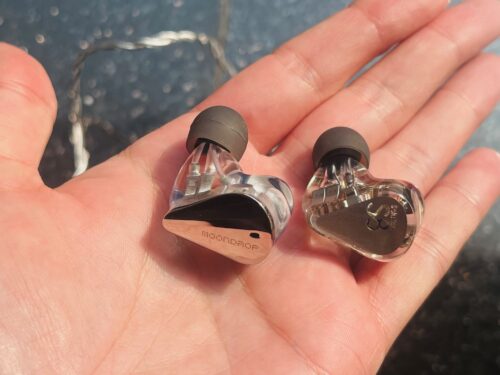
Design
The S8 employs 8 balanced armature drivers in its design, including Knowles and Sonion: 2 bass, 2 treble, and 4 midrange. In contrast, the Blessing 3 combines 4 balanced armatures with 2 dynamic drivers to deliver 6 drivers in total. With almost the same low impedance, both IEMs are equally easy to power. For the purposes off this review, I paired both IEMs with the Dragonfly Cobalt DAC/Amp dongle.
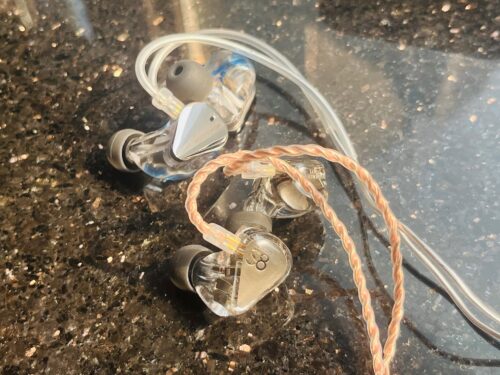
Sound Impressions
Soundstage
Upon first listen, it can feel like the soundstage is more expansive on the Blessing 3; often, instruments on the S8 seem to sit closer to the ear than they do on the Blessing 3. But in truth, the difference lies in the fact that distant instruments on the S8 sound richer and more complete than they do on the Blessing 3. In contrast, distant instruments on the Blessings 3 sound fainter and less delineated. As a result, the S8 tends to reveal a more colorful canvas of sound. But in terms of the dimension they deliver (height, width and depth), both IEMs perform almost equally well. So, the imaging on the Blessing 3 can certainly compete with that of the S8. It just falls behind with respect to resolution.
Low-End
The bass on the S8 is thicker and richer than the bass on the Blessing 3. While both IEMs reach similar sub-bass frequency depths, the S8 presents a heavier and more powerful bass instrument across the entire low-end range. In contrast, the bass on Blessing 3 feels relatively light and fast, delivering a speedier and more restrained character overall. In terms of transparency, both IEMs present an almost equal level of detail in the low-end. But listening to acoustic strings in this range, the Blessing 3 sounded more natural and neutral, while S8 felt more colored and majestic.
Mids
As in the low-end, the S8 remains the more substantial sound in terms of weight and color. The Blessing 3 feels recessed in the lower-midrange, and instead favors the upper mids, which brings vocals forward while dropping some mass. In contrast, the S8 delivers bigger lower frequencies and less forward treble in this range. As a result, the S8 presents is a meatier and more comprehensive balance, while the Blessings 3 delivers a leaner, crisper, and more dynamic sound signature overall.
With respect to resolution, the S8 slightly outperforms the Blessing 3. For example, the separation in the low-mids is cleaner on the S8. And listening to strings in this range, the S8 felt a touch more transparent. So, although the difference in skill is less than vast, a discerning ear will most likely appreciate the extra level of midrange clarity on the S8.
Highs
While there isn’t a remarkable gap between the level of clarity these two IEMs deliver, the S8 seems to paint a more complete picture in the highs. Vocals and strings, for example, have slightly more complex tonal qualities on the S8. And overall, the S8 remains a more sumptuous sound signature in this range, revealing shades and colors that the Blessings 3 ignores. It’s also worth noting that although the Blessing 3 is brighter, both IEMs have an almost equal amount of perceivable treble extension, and both sounded smooth at the highest treble peaks. So, neither model will give you the impression that you are missing out in this range. At the same time, neither IEM is fatiguing in the highs either.
Summary
Although the S8 does have the modest upper hand in terms of performance, the Blessing 3 is certainly no slouch. So, on many levels, the choice between these two models should probably be based more on character than on skill. Those who prefer a rich and powerful sound signature with a fat low-end and comprehensive mids, will likely opt for the S8. On the other hand, those who appreciate a leaner, less colored sound signature with a fast and controlled bass and more dynamic tuning, will probably flock to the Blessing 3.
You can buy the Moondrop Blessing 3 and Moondrop S8 at Audio 46.
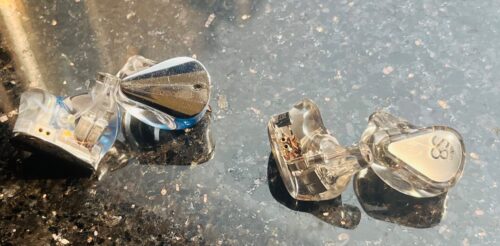
Specifications
| Driver | 2 highs, 4 mids, 2 bass (Dynamic/BA combo) | 2 DD, 4 BA |
| Impedance | 16 Ohms | 14.8 Ohms |
| Sensitivity | 122dB | 120dB |
| Frequency Response | 20-40kHz | 10-30kHz |
MAJORHIFI may receive commissions from retail offers.


